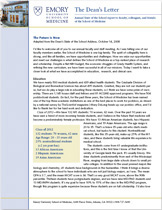Faculty
Now let’s talk about you. In my estimation, you are the greatest single asset of the School of Medicine. Our ability to perform our missions of patient care, education, research, and community service begins and ends with you. Your value is immense. Whether implementing our new curriculum, making remarkable research breakthroughs, providing high-quality patient-centered care to thousands of individuals, or being the role model for the next generation of physicians, you do it—you do it day in and day out and with great skill and dedication. I want you to know that I appreciate you and all that you do.
Our faculty now totals more than 2,100, which puts us up among the largest medical schools. Most of our faculty are in clinical science departments. We had a net gain of 106 faculty last year, an 8.5% growth in basic science departments, and a 5% growth in clinical departments. We were able to appoint four new chairs in 2008, Walter Curran of radiation oncology, Doug Eaton of physiology, Fadlo Khuri, the founding chair of hematology/oncology, and Robert Swerlick of dermatology. We have two current chair searches under way, (1) microbiology and immunology and (2) surgery. Rick Cummings is head of the microbiology and immunology search committee, and for surgery, Carolyn Meltzer and Dan Barrow have co-led the search. Both search committees have made substantial progress, so we should be able to bring those searches to a close soon.
I thought you would be interested to know that we had 34 appointments or promotions to professor last year, 56 appointments or promotions to associate professor, and 286 junior actions. I think these figures are interesting to look at because they address the demographics of the faculty.

We are a faculty of one-third female, two-thirds male, and we have been that way for about the past five years. Almost 13% of our faculty are minority—a figure that’s not bad compared with the average in higher education, but it’s not great either. Of our senior faculty, 20% are female and about 80% are male, and our senior ranks include about 6% under-represented minorities. So we have a ways to go. One new development is that we have created an incentive for departments to recruit senior women and under-represented minorities by setting aside $1 million each year that I will use to match the start-up packages that chairs can provide.
Here are some of the School of Medicine faculty who have received prestigious awards in the past year. Helen Mayberg was elected to the Institute of Medicine and received the Falcone Prize for Outstanding Achievement in mood disorders. Kerry Ressler is now a Howard Hughes investigator. Jeremy Boss was appointed editor of the Journal of Immunology. Carolyn Meltzer was elected vice president of the American Society of Neuroradiology. Robert Taylor is president-elect for the Society of Gynecologic Investigation and also received the distinguished researcher award from the American Society of Reproductive Medicine. Robert Lee, associate dean for minority and multicultural affairs, received a special recognition award from the AAMC Group on Student Affairs. Leon Haley was appointed to the Georgia Trauma Care Network Commission. Max Cooper received a major award from the AAMC for lifetime distinction in research. Lawrence Davis and William Casarella each received the Gold Medal from the American College of Radiology, its highest honor. Last, Malcolm Graham received an award of merit from the American Otolaryngological Society.
Task Force on Faculty and Staff Development
Two years ago, we instituted a task force on faculty and staff development that was co-chaired by Kate Heilpern and Carlos del Rio. The committee was charged with one goal in mind: We want the School of Medicine to be the best place to work in Atlanta and the best place to work among all U.S. medical schools. We want faculty and staff to make valuable contributions, to know that they are appreciated, and to feel included in the vision, goals, and accomplishments of the School of Medicine. So I wanted give you a follow-up on this committee, which brought forward six top recommendations.
- Provide personalized recognition for accomplishments in all departments. One example is the staff awards event in the Department of Medicine, chaired by Wayne Alexander. A number of other departments have been doing this as well, and we have had lots of positive feedback from faculty and staff.
- Appoint an assistant dean for staff development to facilitate training of chairs, division directors, other faculty, and staff. We have appointed an assistant dean, Rachelle Lehner. She and Sharon Weiss are working on enhancing training, and they will be rolling out more initiatives in the coming year.
- Incorporate faculty development in the chair evaluation process. We are developing forms for chair evaluations by faculty, and faculty development is already part of the evaluation of chairs in the dean’s office.
- Provide more development courses in leadership and teaching skills. The departments of pediatrics and medicine, for example, have a faculty development lecture series and course. Radiology has lecture and leadership programs for mid-level faculty. The School of Medicine has a lecture series and a junior faculty development course. For the chairs who haven’t had the time to do this, you really should. Such courses are regarded highly by the faculty and staff.
- Expand and improve mentoring programs at the department and school levels. The biochemistry, pharmacology, and cell biology departments have grant-writing programs, and the school’s postdoctoral education office conducts grant-writing classes for junior faculty.
- Review promotion and tenure guidelines of the School of Medicine for the possibility of creating a clinician educator track. This has been done and is about to come before the council of chairs for review. If approved, it then will go before the provost and then, ultimately, to the board of trustees.
We have implemented as many of the recommendations as possible. There’s more progress to be made, but the chairs and the departments are stepping up in an important way.

